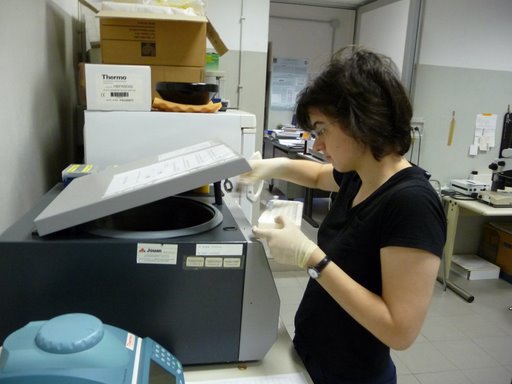From 2009.igem.org
|

|
December 2008
| M | T | W | T | F | S | S |
|
| 1 | 2 | 3 | 4 | 5 | 6 | 7 |
|
| 8 | 9 | 10 | 11 | 12 | 13 | 14 |
|
| 15 | 16 | 17 | 18 | 19 | 20 | 21 |
|
| 22 | 23 | 24 | 25 | 26 | 27 | 28 |
|
| 29 | 30 | 31 | | | | |
|
|
March 2009
| M | T | W | T | F | S | S |
|
| | | | | | | 1 |
|
| 2 | 3 | 4 | 5 | 6 | 7 | 8 |
|
| 9 | 10 | 11 | 12 | 13 | 14 | 15 |
|
| 16 | 17 | 18 | 19 | 20 | 21 | 22 |
|
| 23 | 24 | 25 | 26 | 27 | 28 | 29 |
|
| 30 | 31 | | | | | |
|
|
April 2009
| M | T | W | T | F | S | S |
|
| | | 1 | 2 | 3 | 4 | 5 |
|
| 6 | 7 | 8 | 9 | 10 | 11 | 12 |
|
| 13 | 14 | 15 | 16 | 17 | 18 | 19 |
|
| 20 | 21 | 22 | 23 | 24 | 25 | 26 |
|
| 27 | 28 | 29 | 30 | | | |
|
|
May 2009
| M | T | W | T | F | S | S |
|
| | | | | 1 | 2 | 3 |
|
| 4 | 5 | 6 | 7 | 8 | 9 | 10 |
|
| 11 | 12 | 13 | 14 | 15 | 16 | 17 |
|
| 18 | 19 | 20 | 21 | 22 | 23 | 24 |
|
| 25 | 26 | 27 | 28 | 29 | 30 | 31 |
|
|
|
|
|
|
|
|
|
November 2009
| M | T | W | T | F | S | S |
|
| | | | | | | 1 |
|
| 2 | 3 | 4 | 5 | 6 | 7 | 8 |
|
| 9 | 10 | 11 | 12 | 13 | 14 | 15 |
|
| 16 | 17 | 18 | 19 | 20 | 21 | 22 |
|
| 23 | 24 | 25 | 26 | 27 | 28 | 29 |
|
| 30 | | | | | |
|
|
|
|
Week from June 8th, to June 14th, 2009
June, 8th
- We infected 5 ml of LB + Amp with 15 ul of these glycerol stocks:
| J23100
| J23101
| E0240 (X2 cultures)
|
| P0040
| R0040
| I732017
|
| B0015
|
|
- We incubated the inocula overnight at 37°C, 220 rpm.
June, 9th
- This is the first ligation day! cross your sticky fingers:)
| J23100
| J23101
| E0240 (X2)
|
| P0040
| R0040
| I732017
|
| B0015
|
|
|
|
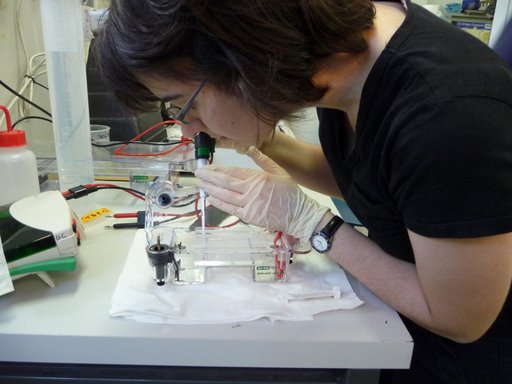 ...and preparing the gel run!
|
| J23100(S-P)
| J23101(S-P)
| E0240(X-P) (X2)
|
| P0040(E-S)
| R0040(E-X)
| I732017(E-S)
|
| B0015(E-X)
|
|
- Gel run and band cut for the digested plasmids. We used two gels: a medium one (short run to separate 1-2 Kb fragments) for J23100(S-P), J23101(S-P), E0240(X-P) (X2), P0040(E-S) and R0040(E-X); a small one (long run to separate 2-3 Kb fragments) for I732017(E-S) and B0015(E-X).
- All the bands in the two gels had the expected size! only R0040 seemed a bit contaminated, but the expected fragment was much brighter than the smear (see figure below). Complete digestion for J23100, J23101, I732017. Incomplete digestion for E0240 (both) and P0440.
- Ligations:
- A1 = J23100(S-P) + E0240(X-P)
- A2 = J23101(S-P) + E0240(X-P)
- A3 = I732017(E-S) + B0015(E-X)
- A4 = P0440(E-S) + R0040(E-X)
- We incubated the ligation reaction overnight at 16°C.
|
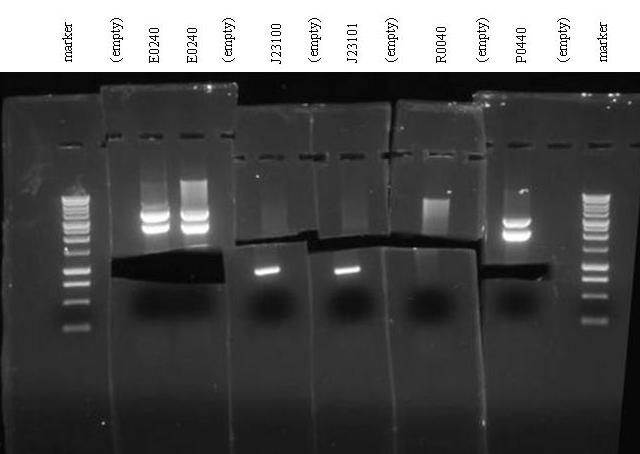 Medium gel after bands cut
|
Preparation of experiment with Tecan F200
- We streaked a plate with E0240 glycerol stock to prepare the bacterial growth test at Tecan F200.
June, 10th
- We transformed the four ligation reactions.
- Quality control results performed by MIT on the extracted lysis BioBricks:
- K124017 BioBrick sequence had been classified as "inconsistent" by MIT (and sequence looked completely wrong!). In the following days we will plan how to substitute this part.
- K131009 had some problems in prefix (1 bp deletion, but does not corrupt restriction sites), suffix (1 bp deletion, but does not corrupt restriction sites) and celB gene (point mutation that changes the amino acid L->M). We decided to sequence this part in the following days.
- K117000 was good.
Preparation of experiment with Tecan F200
- We picked a colony of the freshly streaked E0240 overnight plate and infected 5 ml of LB + Amp.
- We incubated the inoculum overnight at 37°C, 220 rpm.
June, 11th
- We received sequencing results for B0030 and J23100: both sequences were correct, confirming that we were working correctly!:)
- All the four overnight plates showed many colonies! A1 and A2 plates showed only a couple of red colonies...maybe a contamination of the non completely cut plasmids carrying RFP downstream of the promoter...
- Colony PCR for A1, A2 and A4. We decided not to perform it on A3 because the insert was very long (>3 Kb!) and in our opinion colony PCR was not the ideal way to screen the plate. We let the picked colonies grow in 1 ml of LB + Amp, 37°C, 220 rpm for 5 and 1/2 hours, waiting for the end of the PCR screening.
- Gel run for the PCR reactions.
|
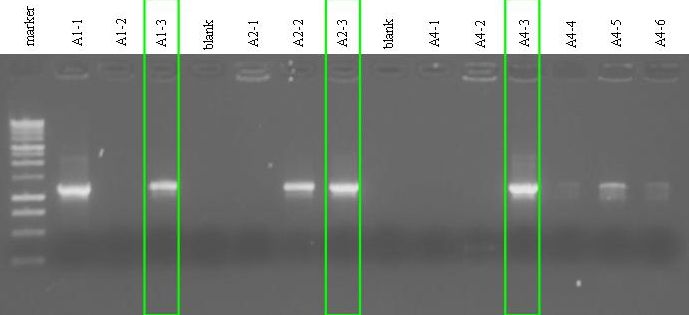 Colony PCR: we had at least a positive colony for each of the three screened plates! we chose the third colony for each plate.
|
- Gel results: A1-2, A2-1 and A4-1 reactions did not show any amplicon...Anyway, the positive reactions gave the expected lengths! We chose:
- 3rd colony for A1 (expected length = ~1100 bp)
- 3rd colony for A2 (expected length = ~1100 bp)
- 3rd colony for A4 (expected length = ~1100 bp)
- NOTE: A4-2 showed a 290 bp band, but in the picture above it's quite hard to see it.
- Glycerol stocks for the chosen colonies.
- We re-filled the remaining 250 ul of the chosen colony of A4 with 5 ml of LB + Amp and incubated the falcon tube at 37°C, 220 rpm overnight.
- We picked five colonies from A3 plate and infected 5 ml of LB + Amp. We incubated them overnight at 37°C, 220 rpm. Tomorrow we will perform miniprep and we will screen the colonies through digestion/electrophoresis.
June, 12th
- Miniprep for the chosen colony of A4.
- Glycerol stocks/miniprep for the five 5 ml overnight cultures of A3.
- We linearized the purified plasmids digesting 1 ug of DNA with PstI in a total digestion reaction volume of 20 ul. We incubated the digestion at 37°C for 3 hours. We also applied this protocol for B0015 plasmid (taken from -20°C freezer) in order to have a negative control.
- NOTE: we expected to find an insert length of 3.2 Kb (I732017+B0015) if the ligation had worked, while we expected an insert length of 129 bp (only B0015) if it had not worked. We decided not to check the length of the inserts because the scaffold vector was about 3.2 Kb long and we could not separate it from the insert without a long gel run...but after a long run, the 129 bp fragment might be lost!
For this reason, we decided to perform a run for the entire linearized plasmids to discriminate a 6.4 Kb fragment from a 3.3 Kb fragment.
- Gel run for the six digestions.
|
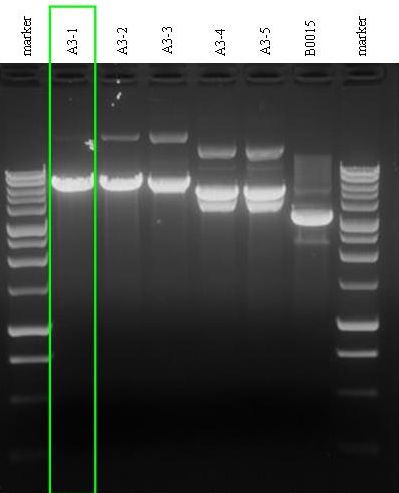 Digestion screening results: A3-1 is the most pure plasmid.
|
- Gel results: A3-1, A3-2 and A3-3 show the expected size of a correctly ligated linearized plasmid...but they show an unexpected identical heavy band, especially A3-2 and A3-3. In addition, the brightest bands of A4 and A5 are two and show a completely wrong size, different from B0015 lane, which corresponds to the expected size of a non ligated plasmid. Even A4 and A5 show an unexpected identical heavy band...All the heavy bands had a constant shift from the brightest bands.
Maybe they are nicked DNA, but if you read this notebook and you have a different explanation, please e-mail: lorenzo.pasotti@unipv.it ...thank you:)
- Next reactions will be performed with A3-1, which is the most pure colony.
- Meeting for wiki planning.

 Previous Week
Previous Week

 Previous Week
Previous Week

 "
"

